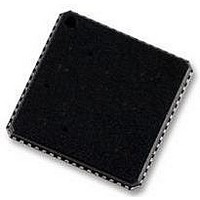ADSP-BF592KCPZ Analog Devices Inc, ADSP-BF592KCPZ Datasheet - Page 10

ADSP-BF592KCPZ
Manufacturer Part Number
ADSP-BF592KCPZ
Description
58T4522
Manufacturer
Analog Devices Inc
Specifications of ADSP-BF592KCPZ
Operating Temperature (min)
0C
Operating Temperature (max)
70C
Operating Temperature Classification
Commercial
Mounting
Surface Mount
Pin Count
64
Rohs Compliant
YES
Frequency
400MHz
Embedded Interface Type
PPI, SPI, UART
No. Of I/o's
32
Operating Temperature Range
0°C To +70°C
Digital Ic Case Style
LFCSP
No. Of Pins
64
Core Supply Voltage
1.4V
Lead Free Status / RoHS Status
Compliant
Available stocks
Company
Part Number
Manufacturer
Quantity
Price
Company:
Part Number:
ADSP-BF592KCPZ-2
Manufacturer:
BROADCOM
Quantity:
154
ADSP-BF592
video (EAV) and start of active video (SAV) preamble symbols,
or any data present during the vertical blanking intervals. In this
mode, the control byte sequences are not stored to memory;
they are filtered by the PPI. After synchronizing to the start of
Field 1, the PPI ignores incoming samples until it sees an SAV
code. The user specifies the number of active video lines per
frame (in PPI_COUNT register).
Vertical Blanking Interval Mode
In this mode, the PPI only transfers vertical blanking interval
(VBI) data.
Entire Field Mode
In this mode, the entire incoming bit stream is read in through
the PPI. This includes active video, control preamble sequences,
and ancillary data that may be embedded in horizontal and ver-
tical blanking intervals. Data transfer starts immediately after
synchronization to Field 1. Data is transferred to or from the
synchronous channels through eight DMA engines that work
autonomously from the processor core.
TWI CONTROLLER INTERFACE
The processors include a two-wire interface (TWI) module for
providing a simple exchange method of control data between
multiple devices. The TWI is functionally compatible with the
widely used I
capabilities of simultaneous master and slave operation, support
for both 7-bit addressing and multimedia data arbitration. The
TWI interface utilizes two pins for transferring clock (SCL) and
data (SDA) and supports the protocol at speeds up to 400K
bits/sec.
The TWI module is compatible with serial camera control bus
(SCCB) functionality for easier control of various CMOS cam-
era sensor devices.
PORTS
The processor groups the many peripheral signals to two
ports—Port F and Port G. Most of the associated pins are shared
by multiple signals. The ports function as multiplexer controls.
General-Purpose I/O (GPIO)
The processor has 32 bidirectional, general-purpose I/O (GPIO)
pins allocated across two separate GPIO modules—PORTFIO
and PORTGIO, associated with Port F and Port G respectively.
Each GPIO-capable pin shares functionality with other proces-
sor peripherals via a multiplexing scheme; however, the GPIO
functionality is the default state of the device upon power-up.
Neither GPIO output nor input drivers are active by default.
Each general-purpose port pin can be individually controlled by
manipulation of the port control, status, and interrupt registers:
• GPIO direction control register – Specifies the direction of
• GPIO control and status registers – The processor employs
each individual GPIO pin as input or output.
a “write one to modify” mechanism that allows any combi-
nation of individual GPIO pins to be modified in a single
instruction, without affecting the level of any other GPIO
pins. Four control registers are provided. One register is
2
C
®
bus standard. The TWI module offers the
Rev. PrC | Page 10 of 46 | August 2010
DYNAMIC POWER MANAGEMENT
The processor provides five operating modes, each with a differ-
ent performance/power profile. In addition, dynamic power
management provides the control functions to dynamically alter
the processor core supply voltage, further reducing power dissi-
pation. When configured for a 0 volt core supply voltage, the
processor enters the hibernate state. Control of clocking to each
of the processor peripherals also reduces power consumption.
See
Full-On Operating Mode—Maximum Performance
In the full-on mode, the PLL is enabled and is not bypassed,
providing capability for maximum operational frequency. This
is the power-up default execution state in which maximum per-
formance can be achieved. The processor core and all enabled
peripherals run at full speed.
Active Operating Mode—Moderate Dynamic Power
Savings
In the active mode, the PLL is enabled but bypassed. Because the
PLL is bypassed, the processor’s core clock (CCLK) and system
clock (SCLK) run at the input clock (CLKIN) frequency. DMA
access is available to appropriately configured L1 memories.
In the active mode, it is possible to disable the control input to
the PLL by setting the PLL_OFF bit in the PLL control register.
This register can be accessed with a user-callable routine in the
on-chip ROM called bfrom_SysControl(). If disabled, the PLL
control input must be re-enabled before transitioning to the
full-on or sleep modes.
• GPIO interrupt mask registers – The two GPIO interrupt
• GPIO interrupt sensitivity registers – The two GPIO inter-
Table 4
written in order to set pin values, one register is written in
order to clear pin values, one register is written in order to
toggle pin values, and one register is written in order to
specify a pin value. Reading the GPIO status register allows
software to interrogate the sense of the pins.
mask registers allow each individual GPIO pin to function
as an interrupt to the processor. Similar to the two GPIO
control registers that are used to set and clear individual
pin values, one GPIO interrupt mask register sets bits to
enable interrupt function, and the other GPIO interrupt
mask register clears bits to disable interrupt function.
GPIO pins defined as inputs can be configured to generate
hardware interrupts, while output pins can be triggered by
software interrupts.
rupt sensitivity registers specify whether individual pins are
level- or edge-sensitive and specify—if edge-sensitive—
whether just the rising edge or both the rising and falling
edges of the signal are significant. One register selects the
type of sensitivity, and one register selects which edges are
significant for edge-sensitivity.
for a summary of the power settings for each mode.
Preliminary Technical Data














